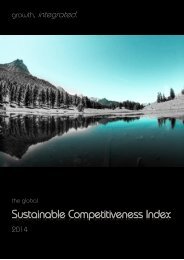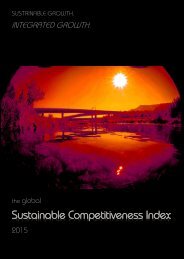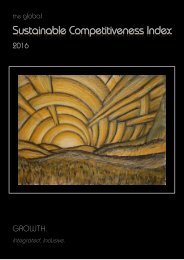Sustainable_Competitiveness_Index_2013
You also want an ePaper? Increase the reach of your titles
YUMPU automatically turns print PDFs into web optimized ePapers that Google loves.
<strong>Sustainable</strong> <strong>Competitiveness</strong><br />
Regional Spread<br />
Scandinavia<br />
North-western Europe<br />
Australia & New Zealand<br />
North America<br />
North-east Asia<br />
Eastern Europe<br />
Southern Europe<br />
South America<br />
South-east Asia<br />
Central Asia<br />
Northern Africa<br />
Central America<br />
Western Africa<br />
Southern Africa<br />
Middle East<br />
Eastern Africa<br />
0 10 20 30 40 50 60<br />
-50% -30% -10% 10% 30% 50%<br />
Denmark<br />
Ireland<br />
Slovenia<br />
Italy<br />
Malta<br />
Bhutan<br />
Hungary<br />
Chile<br />
Greenland<br />
Mauritius<br />
Nepal<br />
India<br />
Mongolia<br />
Jamaica<br />
Senegal<br />
Malawi<br />
Guinea<br />
Iran<br />
Burundi<br />
West Bank and Gaza<br />
Regional spread<br />
Scandinavia as a region achieves the highest<br />
<strong>Sustainable</strong> <strong>Competitiveness</strong> score, followed<br />
by North-Western Europe, Australia & New<br />
Zealand, North America and North-East Asia –<br />
all areas in the Northern hemisphere. Central<br />
Asia is the only region that doesn't fit into the<br />
North-South divide. From a European<br />
perspective, it is interesting to note that<br />
Eastern Europe achieves a higher score than<br />
Sothern Europe (which has nominally higher<br />
income levels). All African Regions are in the<br />
bottom half, joined by Central America and<br />
the Middle East. The high-income countries of<br />
the Middle East have sustained their<br />
economic success with the exploitation of<br />
their mineral resources. The low <strong>Sustainable</strong><br />
<strong>Competitiveness</strong> of the region raises concerns<br />
on whether those countries will be able to<br />
maintain or sustain their development level<br />
once there fossil fuel wealth subsidies.<br />
Part of the objective of this index was to<br />
evaluate whether the commonly poor<br />
outlook of African nations would look different<br />
when measured against non-financial<br />
indicators. Unfortunately, this seems not to be<br />
the case.<br />
Average deviation<br />
Only 38% of the 176 countries assessed<br />
<strong>Sustainable</strong> <strong>Competitiveness</strong> score is above<br />
the average score, i.e. nearly two thirds (62%)<br />
are below the average score. The large<br />
difference means that there is large gap<br />
between the leading scores (the top 40<br />
nations) and the rest of the World.<br />
10<br />
The <strong>Sustainable</strong> <strong>Competitiveness</strong> <strong>Index</strong> <strong>2013</strong><br />
Table of contents<br />
25








